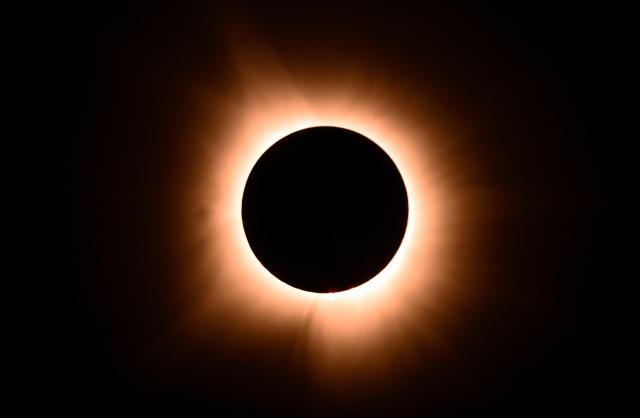Across Mexico, the US, and Canada, within a swath of land stretching 155 miles wide but spanning over 4,000 miles in length, tens of millions of people tilted their heads skyward in wonder as day turned to night.
What unfolded on Monday was a spectacle unlike any other: the Moon’s graceful passage between Earth and Sun, shrouding its luminance in a total solar eclipse.
The path of totality traversed the continent, commencing over the sun-kissed beaches of a Mexican coastal town, casting darkness over the roaring waters of Niagara Falls, and concluding its celestial voyage on the shores of Newfoundland, Canada.
In its aftermath, a profound sense of awe lingered, a poignant reminder of our planet’s cosmic context.
The eclipse made its debut near Mazatlán, Mexico, on the western coast at 11:07 local time (18:07 GMT).
Initially, the Moon’s silhouette delicately grazed the Sun’s edge, gradually engulfing more until jubilation erupted as daylight gave way to darkness—except for the ethereal shimmer of the Sun’s corona encircling the Moon’s silhouette.Intermittently obscured by drifting clouds, the eclipse eventually rendered the Sun a mere memory, leaving behind only faint glimmers of light encircling the Moon.
From there, the eclipse continued its trajectory northeastward across the United States.
For some, the solar spectacle coincided with personal milestones, with hundreds of Americans partaking in mass wedding ceremonies held along the path of totality.
In Russellville, Arkansas, 300 couples from diverse backgrounds exchanged vows just before darkness descended. As daylight reemerged, the newlyweds celebrated with cake-cutting and dancing, all part of the aptly named Total Eclipse of the Heart festival.
Further along the path, in Ellsinore, Missouri, amateur astronomer Darcy Howard eagerly awaited, having journeyed from her central Arkansas residence to ensure clear skies for viewing.
Having witnessed numerous eclipses in the past, including two total eclipses, one annular, and two partials, Howard remarked on the distinctiveness of each event. “Each one has its own essence,” she noted.
Today’s totality, occurring around 13:56 local time (18:56 GMT), enveloped the surroundings in an “eerie twilight,” Howard recounted, with dusky hues lining the horizon. The corona shone nearly as bright as a full moon, imbuing the moment with a sense of otherworldly enchantment.
Having harbored a lifelong passion for the cosmos, ignited by her father’s introduction to celestial wonders in her youth, Howard reflected on the solace she finds in stargazing. “When I gaze through a telescope and behold Jupiter… when I catch a glimpse of Saturn, I am reassured that all is well in the universe,” she concluded.

